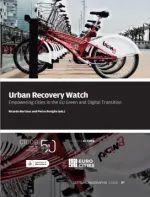Visegrad 4 cities in the implementation of next generation EU - a lost opportunity?

The Visegrad Group (V4) countries – the Czech Republic (hereafter Czechia), Hungary, Poland and Slovakia – are at different stages of the EU’s Recovery and Resilience Facility (RRF) process. All four countries have had their National Recovery and Resilience Plan (NRRP) approved by the European Council. This happened in 2021 for Czechia and Slovakia, while it came much later for Poland (June 2022) and Hungary (December 2022). From any perspective, the clear frontrunners in the RRF process among the V4 are Czechia and Slovakia. Both countries have signed their operational arrangements with the European Commission, received prefinancing and collected the first disbursements (one tranche for Czechia, two for Slovakia). Poland and Hungary, on the other hand, are trailing behind. Neither has received any payment yet and in Hungary’s case, it has still to sign the operational arrangements.
The delay on the part of the latter two countries is all the more striking as even the countries commonly considered the stragglers among the EU partners are much further forward in the RRF process: both Romania and Bulgaria received their first payments in the course of 2022. The explanation for the disappointing RRF situation in Poland and Hungary is linked to the ongoing rule of law conditionality procedure, which requires both countries to fulfil a given number of conditions (milestones) before the disbursement of RRF resources can start.
For all these reasons, the cities of the V4 countries are discussed in two groups in this paper: cities in Czechia (Prague and Brno) and Slovakia (Bratislava) fall into the more advanced category, while cities in Poland (Warsaw) and Hungary (Budapest) are the stragglers.